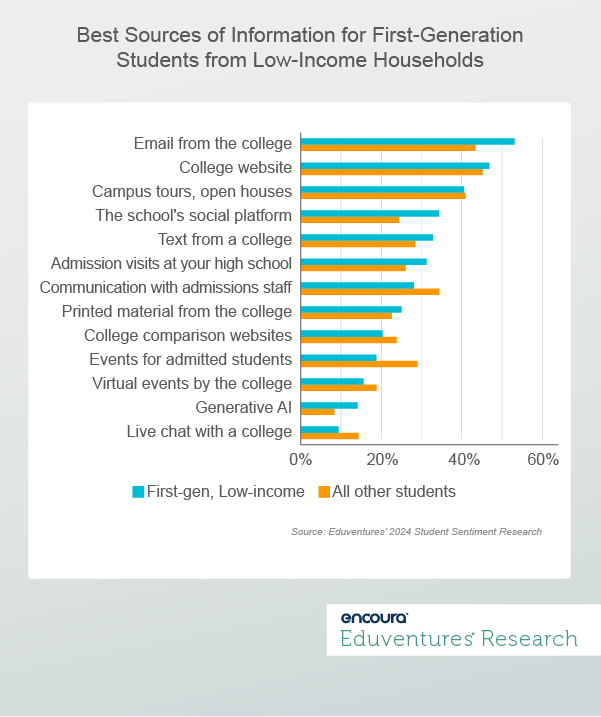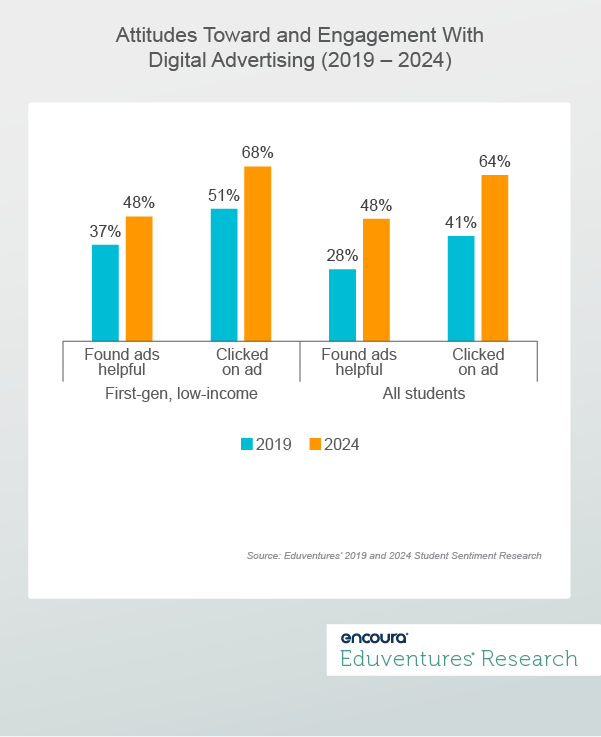Most deposit deadlines have now passed, providing initial fall headcounts and ushering in the summer tradition of monitoring melt. This year feels different, however. The FAFSA conundrum has left everyone—institutions, students, and their families—uncertain about what fall may look like.
One student segment is feared to be most affected: first-generation students from low-income households. In a previous Wake-Up Call, we discussed how an increasing number of these students have already decided against college in recent years, while those left in the funnel look different than before. Today, we turn our attention to how we can keep them engaged.
Digital vs. Personal
This student segment has shrunk since 2019, but to weather strong demographic headwinds coming our way, reengaging them is critical—especially now with the FAFSA delay.
Drawing on findings from the Eduventures 2024 Student Sentiment Research™ Survey, Figure 1 shows the highest rated information sources among first-generation students from low-income households compared to all other students at the time of the enrollment decision.
Figure 1.
Figure 1 reveals that, like students generally, first-generation students from low-income households prefer a variety of communication channels, but rate emails, college websites, and campus tours the highest during the yield stage (53%, 47%, and 41%, respectively). Apart from other students, however, this segment rates a college’s social platform, text messages, high school admissions visits, and generative AI more highly than other students (10, 5, 5, and 6 percentage points higher). Notably, they also rate emails 10 percentage points higher than all other students.
They are less likely to cite communications with admissions staff and events for admitted students as valuable sources. Many first-generation, low-income students face significant barriers to visiting their colleges of interest but are interested in connecting with your institution if you meet them where they are—at their high schools or in many virtual spaces.
This indicates that digital information sources, like emails, text messages, and social media campaigns, become more important when yielding these students. Common yield activities like admitted student events, however, may miss many of them.
How to Reach Those Who Have Stopped Paying Attention?
Figure 2 shows that digital ad campaigns, either on social or the web in general, can also be an effective way to gain—or regain—the attention of this important student segment.
Figure 2.
Figure 2 shows that before the pandemic, digital ads and sponsored posts from colleges were more effective among first-generation students from low-income households (37%) than with the average student (28%). Not only does this segment view college ads as more helpful, more than half of them (51%) indicated they had clicked on an ad, compared to 41% of all students.
In 2024, the gap between first-generation, low-income students and the average student is less pronounced. Today, the two student populations find the ads equally helpful (48%) and those who are first-generation and from low-income households are only slightly more likely to click on an ad than their peers (68% vs. 64%).
This indicates that the perception of college-sponsored ads is increasing among all populations—by 11 percentage points among first-generation, low-income students and by 20 percentage points among the general population. It is likely safe to assume the same is true among high schoolers who consider putting their college plans on ice, making sponsored ads an increasingly important way of keeping students engaged over the spring and summer and ensuring that important deadlines are kept.
The Bottom Line
First-generation students from low-income households have created a dwindling student segment in the college pipeline for some time and continue to face new challenges, including the latest FAFSA turmoil. Nonetheless, they are an important segment for colleges who are facing their own uncertain futures.
To ensure equity in higher education and, perhaps equally important, to secure future enrollments, institutions must find ways to bring these students back. This can be done in several ways:
- Email campaigns. First-generation students from low-income households who remain in the college pipeline say they read the emails they receive from institutions. Email campaigns that address key concerns for these students— cost, debt, and job outcomes—can open the lines of communication.
- Social platform engagement and digital advertising. The data suggests that digital ads directed at low-income neighborhoods can help catch the attention of students who have given up on the idea of college and re-engage those who are not certain if they should move ahead with fall enrollment.
- Stakeholder engagement. Aside from digital sources detailed in this post, Eduventures data also indicates that these students appreciate outreach through their high school orbits. High school counselors, teachers, and parents are also trusted partners in their college searches. Institutions need to apply a grassroots approach to keep these students engaged.




